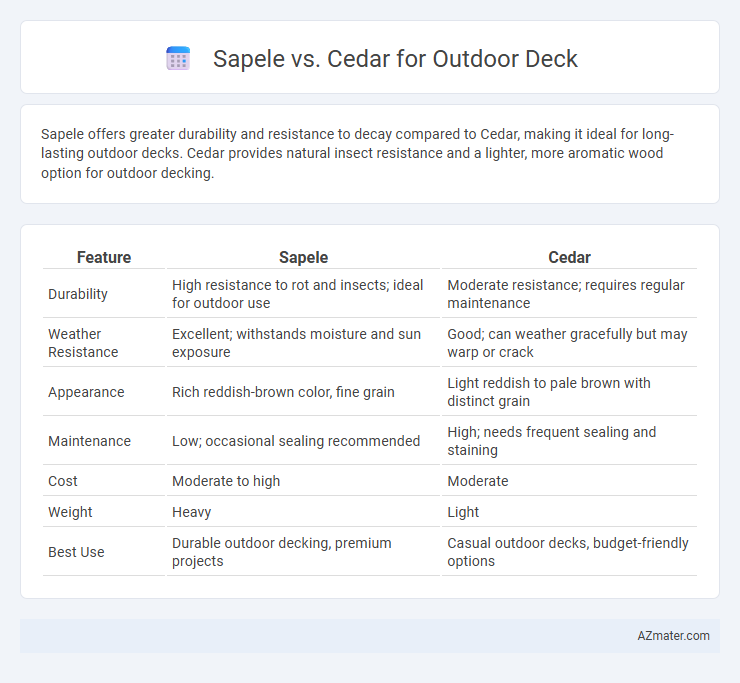Sapele offers greater durability and resistance to decay compared to Cedar, making it ideal for long-lasting outdoor decks. Cedar provides natural insect resistance and a lighter, more aromatic wood option for outdoor decking.
Table of Comparison
| Feature | Sapele | Cedar |
|---|---|---|
| Durability | High resistance to rot and insects; ideal for outdoor use | Moderate resistance; requires regular maintenance |
| Weather Resistance | Excellent; withstands moisture and sun exposure | Good; can weather gracefully but may warp or crack |
| Appearance | Rich reddish-brown color, fine grain | Light reddish to pale brown with distinct grain |
| Maintenance | Low; occasional sealing recommended | High; needs frequent sealing and staining |
| Cost | Moderate to high | Moderate |
| Weight | Heavy | Light |
| Best Use | Durable outdoor decking, premium projects | Casual outdoor decks, budget-friendly options |
Introduction: Sapele vs Cedar for Outdoor Decks
Sapele and cedar are popular hardwood choices for outdoor decks, known for their durability and natural resistance to decay. Sapele offers a rich, reddish-brown hue with a dense grain structure, providing exceptional hardness and weather resistance. Cedar, prized for its aromatic properties and natural oils, delivers a warm, light color and outstanding resistance to moisture and insect damage.
Wood Characteristics: Sapele and Cedar Compared
Sapele wood is known for its rich reddish-brown color, high density, and natural resistance to rot and insects, making it durable for outdoor decking. Cedar offers a lighter color palette with natural oils that provide excellent resistance to decay and insects, along with a softer texture that enhances comfort underfoot. Both woods exhibit good dimensional stability, but Sapele's hardness surpasses Cedar, making it more resistant to dents and wear in high-traffic outdoor environments.
Durability and Weather Resistance
Sapele, a hardwood from the African mahogany family, offers excellent durability and natural resistance to rot and insect damage, making it well-suited for outdoor decks exposed to variable weather conditions. Cedar, known for its natural oils and tight grain, provides superior resistance to moisture, decay, and warping, ensuring long-lasting performance in humid and rainy climates. Both woods are dimensionally stable; however, Sapele tends to be harder and more resistant to physical wear, while Cedar excels in maintaining its moisture balance and resisting fungal growth.
Maintenance Requirements for Each Wood
Sapele requires moderate maintenance with periodic cleaning and sealing to prevent moisture damage and UV fading, making it suitable for outdoor decks in varied climates. Cedar offers natural resistance to rot and insects, reducing the need for chemical treatments but still benefits from regular sealing to maintain its color and durability. Both woods demand annual inspections to identify and address surface wear or potential structural issues, ensuring longevity and aesthetic appeal.
Appearance and Aesthetic Appeal
Sapele offers a rich, reddish-brown hue with a fine, interlocking grain that darkens over time, providing a warm and luxurious aesthetic ideal for outdoor decks. Cedar features a lighter, natural reddish tone with a straight grain and occasional knots, exuding a rustic charm while naturally resisting decay and insects. Both woods enhance outdoor spaces but Sapele's deep color and smooth texture create a more sophisticated appearance compared to Cedar's classic, organic look.
Cost Comparison: Sapele vs Cedar
Sapele decking typically costs between $8 and $12 per square foot, offering a mid-range price compared to cedar, which ranges from $5 to $10 per square foot. The higher initial expense of sapele reflects its superior durability and resistance to decay, potentially reducing long-term maintenance costs. Cedar's affordability makes it attractive for budget-conscious projects, but it may incur additional expenses over time due to more frequent treatments and repairs.
Workability and Installation Ease
Sapele offers moderate workability with a dense grain that requires sharp tools but yields a smooth finish, while cedar provides superior workability due to its softer, lighter wood that is easier to cut and shape. Installation ease favors cedar as it is less prone to splintering and warping during handling, making it a preferred choice for DIY outdoor decking projects. Sapele's hardness may necessitate pre-drilling for screws, whereas cedar's dimensional stability reduces the need for additional adjustments post-installation.
Environmental Impact and Sustainability
Sapele wood, sourced primarily from West Africa, is considered more sustainable when harvested from certified plantations, offering a dense, durable option with moderate environmental impact due to responsible forestry practices. Cedar, especially Western Red Cedar from North America, is valued for its natural resistance to decay without chemical treatments, but concerns about overharvesting and habitat loss require careful sourcing from well-managed forests such as those certified by FSC. Choosing FSC-certified Sapele or Cedar decks ensures reduced carbon footprint and promotes ecosystem preservation while providing long-lasting outdoor decking solutions.
Pros and Cons of Sapele Decking
Sapele decking offers exceptional durability and natural resistance to rot and insects, making it ideal for outdoor decks in humid or wet climates. Its rich reddish-brown color and fine grain enhance aesthetic appeal while requiring minimal maintenance compared to Cedar, which is softer and more prone to dents and scratches. However, Sapele can be heavier and more expensive than Cedar, and it may require pre-drilling for fasteners due to its density.
Pros and Cons of Cedar Decking
Cedar decking offers natural resistance to rot, decay, and insect attacks, making it a durable choice for outdoor decks. Its lightweight and easy-to-work-with properties allow for simple installation and maintenance, while its rich color and aromatic scent enhance the aesthetic appeal. However, cedar is softer than hardwoods like Sapele, which means it can be prone to dents, scratches, and weathering over time, requiring more frequent upkeep to maintain its appearance.

Infographic: Sapele vs Cedar for Outdoor Deck
 azmater.com
azmater.com